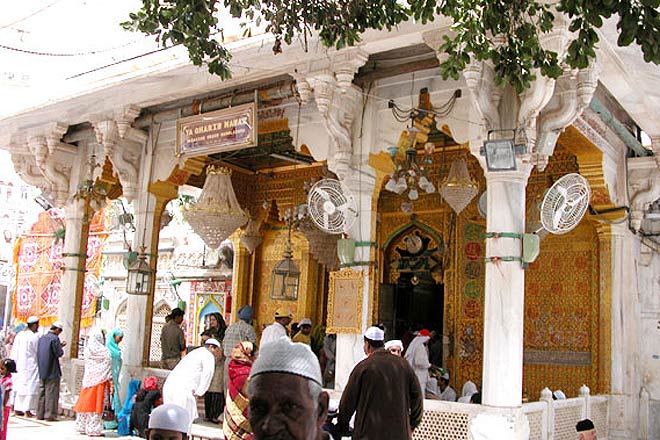 sizes="(max-width: 660px) 100vw, 660px" />
sizes="(max-width: 660px) 100vw, 660px" />
Ajmer Sharif, Rajasthan
An important pilgrimage site for Muslims, the dargah of Sufi saint, Khwaja Muin-ud-din Chisti draws people of all faiths. Hence it is crowded at all hours and bursting at the seams during festivals. The saint’s tomb lies beneath a silver canopy inlaid with mother-of-pearl, which was presented by Emperor Jehangir. Do not miss the two huge cauldrons (degs), donated by the Moghul emperors, for distribution of food to the poor. There are other mosques, tombs and elaborately built halls within the premises. The khadims will beseech you for monetary donations but it is not compulsory. A trip to Ajmer is usually combined with a visit to Pushkar. www.rajasthantourism.gov.in.

Auroville, Tamil Nadu
The Matrimandir, located in the heart of Auroville, looks like a giant space craft to the uninitiated. To those in the know, it is a meditation hall for the members of the Auroville community. They strongly discourage visitors from considering it as a touristy attraction. Even to see Matrimandir from outside, you need special passes and compulsorily sit through a short introductory video show. www.auroville.org.
Dilwara Temple, Rajasthan
An important pilgrimage centre for Jains, the temple’s architecture makes it a popular tourist attraction too. Located near Mt. Abu, the temples have been built between 11th and 13th centuries and are dedicated to the different Jain Tirthankars. The temples are open between 12-3pm for tourists. www.rajasthantourism.gov.in.

Golden Temple, Punjab
Located in Amritsar, the Har Mandir Sahib (also called Hari Mandir Sahib) or the Golden Temple is the holiest shrine for the Sikh community. But people of all faiths can enter the temple (you have to cover your head) and partake of the meal served here. The temple stands in the middle of the sacred lake, the Amrit Sarovar, and can be approached through a causeway. The holy book, Guru Granth Sahib, was first installed in the Har Mandir Sahib in 1604. www.goldentempleamritsar.org.

Hemis Monastery, Jammu and Kashmir
One of the rare monasteries of Ladakh that holds its main festival in summer (usually in June) is located about 45km south of Leh town. The 17th century, with colourful frescoes adorning its walls, houses a three-storey statue of Guru Padmasambhava. Every 12 years, the monastery hold a special ceremony where one of its old and large thangka (painted scroll) is unfurled for public viewing (the next display is in 2016). The monastery is open to people of all faiths. www.jktourism.org.

Jagannath Temple, Odisha
Located in the beach town of Puri, the temple grants entry to Hindus only. In the sanctum sanctorum reside the three deities, Jagannath, Subhadra and Balabhadra. Every year (in June-July), the idols are taken out for a chariot procession (Rathayatra), where the chariots are pulled by the thousands of devotees present on the spot. The architecture of the 12th century temple is worth noting. In 2015, the temple is celebrating the Nabakalebara during the annual Rathayatra festival, when the old wooden idols will be replaced by new ones. People of all faiths can attend the Rathayatra festival. Odisha state tourism has organised special packages (www.otdc.in/nabakalebara2015.htm) for visitors for the entire duration of the festival and the events leading up to it. www.orissatourism.gov.in.
Mahaparinirvana Express
In 2007, the Indian ministry of railways launched this special tourist train for the benefit of Buddhist pilgrims. The train leaves from Delhi and covers major Buddhist pilgrimage centres across North India, viz. Bodh Gaya, Rajgir, Nalanda, Sarnath, Sravasti, and Kushinagar/Lumbini. As these centres are not on the rail route, the passengers are taken to the nearest railway station (Gaya, Varanasi, Gorakhpur, etc) and then onwards by road. The trip also includes a visit to Agra and the Taj Mahal before terminating in Delhi. The train runs on fixed days (the next phase of travel is scheduled between September 2015 and March 2016). www.irctctourism.com.
Iranshah Atash Behram, Gujarat
Located in Udvada, a small town near the Maharashtra-Gujarat border, this fire temple is a major pilgrimage centre for Zoroastrians all over the world. Built in 1742, this is said to be world’s oldest existing Atash Behram. However, people of other faith are not allowed inside. The real estate boom in the region is a threat to this quaint town that still contains old-fashioned buildings. The ageing population initially frowns upon non-Zoroastrian visitors but are very friendly if you can prove your intentions are good. www.gujarattourism.com.

Vaishno Devi, Jammu and Kashmir
The scenic surroundings and the enchanting journey, which make a trip to this hill-top Hindu pilgrimage centre near Jammu an unforgettable experience, has won Vaishno Devi the top position in the ‘spiritual journeys’ category of the Outlook Traveller Awards 2015. One has to compulsorily register at the office in Katra (48km from Jammu), abide by the timings mentioned on the registration slips and follow a number of procedures, before being finally allowed to enter the cave temple. Apparently, there are a number of spurious websites that promise ‘yatra’ tickets and other facilities but fail to deliver. www.maavaishnodevi.org.

Velankanni Church, Tamil Nadu
The Basilica of Our Lady of Good Health is located in Vailankanni town, about 350km south of Chennai, and is an important pilgrim centre for Roman Catholics. Popularly called the ‘Lourdes of the East’ (after Lourdes of France), it is also visited by people of other faiths. Portuguese sailors who miraculously escaped drowning off the coast came to offer their respect to the small chapel and helped to build a permanent structure. The shrine was later renovated in 1920 and 1933. There is a museum opposite the church. www.tamilnadutourism.org.


